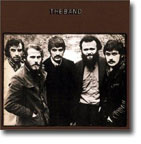Music |
The Band
By
Published: Jan 01, 2007
Category:
Rock
Eric Clapton loved The Band so much that he wanted to quit Cream and join it. How to make that happen? In 1968, he drove up to Woodstock with this idea: They’d spend an afternoon playing together and, soon enough, The Band would invite him in.
The Band was very happy indeed to have such a distinguished visitor.
Until, that is, Clapton said, “Can we jam?”
“We don’t jam,” he was told. “We rehearse.”
The difference is key. Jamming is about self-expression and the creative moment — and back in the ’60s, that let-it-all-hang-out attitude prevailed. You rehearse, on the other hand, when the creative has jelled, when you know what you want to communicate. Rehearsal is preparation for a certain kind of performance, in which note-perfect means a lot more than a guitar riff you’ve never heard before and never will again.
Eric Clapton didn’t get to play with The Band. Or join it.
Just as well. For although all but one of its members came from Canada, The Band is perhaps the most American of all groups. Musicians in beards and old clothes, singing songs of carnivals and Dixie’s defeat — The Band evokes images of a long-gone rural America.
None of that is accidental. Take the album cover, the first way a group has of branding itself. Many fine photographers were suggested. Finally, Robbie Robertson asked, “Who’s the worst photographer in New York?” No one quite knew, but several were quite sure that Rat was the worst magazine — and Elliott Landy was Rat’s go-to photographer. As luck would have it, Landy was not only gifted, he had a real affection for blue-collar America. His photos captured the essence of The Band: a line of workmen in a common enterprise, a band of brothers.
As for the music, it was pure melting pot. You can’t really call these CDs rock; The Band draws on gospel, blues, folk, rhythm and blues, and, at the end of that line, rock. The instrumental interweavings, the way the voices play off one another — everything reinforced the central idea. Great music, no stars.
I was living on a commune in Western Massachusetts when The Band’s first album, “Music from Big Pink”, was released. All around me, the back-to-the-landers were trying to forge a new life; on this album, The Band had created it. “The Weight” and “Long Black Veil” and “Tears of Rage” and “Chest Fever” — every track offered a prize to the close listener.
But it was the second album — called, simply, “The Band” — that wins immortality for the group. “The Night They Drove Old Dixie Down” and “Up on Cripple Creek” and “Look Out Cleveland” and “King Harvest” — if I’m not careful, I could type out the title of every song on the album. It’s that classic.
The Band went downhill after 1969. There was one revival: a 1976 Martin Scorcese film, “The Last Waltz,” about the group’s final concert. It’s amazing. But I do understand what critic Dave Marsh means when he writes that, in the film, “Robbie Robertson demonstrated that he is one of the few people capable of making Bob Dylan seem humble.”
True, but as the man said, “It ain’t bragging if you can do it.” When I first heard The Band, I thought, “It doesn’t get better than this.” And in almost 40 years, it hasn’t.
To buy “Music from Big Pink” from Amazon.com, click here.
To buy “The Band” from Amazon.com, click here.
To buy “The Band’s Greatest Hits” from Amazon.com, click here.
To buy the DVD of “The Last Waltz” from Amazon.com, click here.


